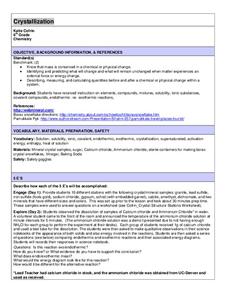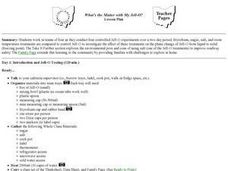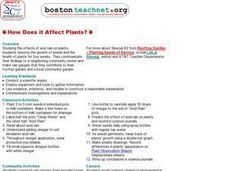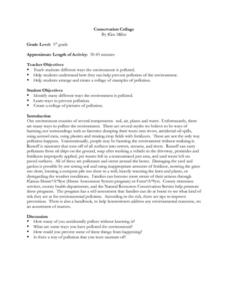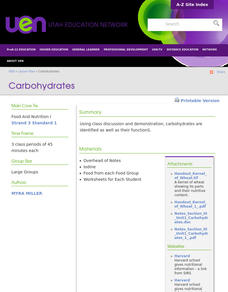Curated OER
Crystallization
Eighth graders analyze physical change in mass. In this chemistry activity, 8th graders describe, measure and calculate the amount of physical change occurring in mass before and after the change. Students should be familiar with...
Curated OER
States of Consciousness
Students investigate sleep. In this psychology lesson, students discuss five environmental factors leading to stress related to sleep.
Curated OER
Cake Batter Lava
Students examine how lava flows change the landscape. In this lava lesson students complete a lab activity where they create a lava flow using cake batter.
Curated OER
Smog Be Gone
Students begin the instructional activity by identifying greenhouse gases. In groups, they observe and record the effect of the gases on the atmosphere and the temperature of the Earth. They participate in activities that describe the...
Curated OER
Snail Observation Exercise
Students are given a pond snail in a clear glass and asked to make observations on the snail's form and behavior. One of the key ideas is that seemly common subjects (like snails) often have surprising or interesting properties.
Curated OER
What's the Matter with My Jell-o?
Learners work in teams of four as they conduct four controlled Jell-O experiments over a two-day period. The Family Page extends this learning to the community by providing families with challenges to explore at home.
Curated OER
Ecosystem Soil Study
Sixth graders take soil samples and analyze the samples and ecosystems found within them.
Curated OER
How Can You Prevent Spoilage?
Students complete laboratory activity to discover what temperature is most effective in prohibiting bacterial growth in two percent milk. Students then write lab report detailing findings.
Curated OER
Journey to the Afterlife
Students work together to design an Egyptian funerary barge. They discover the importance of the afterlife to Egyptians. They create their boat and share their design with the class. They compare and contrast the technology of Ancient...
Curated OER
Critter? Growth
Learners identify and use the elements of the scientific inquiry to solve problems. They explain concepts about the structure and properties of matter. Pupils write an explanation of polymers and how the characteristic of polymers...
Curated OER
Breaking News English: Keep Warm to Avoid Colds: Scientists
In this English learning exercise, students read "Keep Warm to Avoid Colds: Scientists," and then respond to 47 fill in the blank, 7 short answer, 20 matching, and 8 true or false questions about the selection.
Curated OER
Benthic Macroinvertebrates
Students survey and describe a stream ecosystem. They sample the benthic macroinvertebrate populations of a given stream and determine community structure through the use of the Chandler Index and a species diversity index.
Curated OER
How Does it Affect Plants?
Young scholars examine the effects of acid rain on plants. They observe the growth of seeds and the health of different plants for a month. They share their findings with the community.
Curated OER
The Numbers Game
Students examine how to calculate the part-per-million and part-per-billion units used to measure contaminant concentrations in the environment. They calculate ratios, take a quiz, analyze a sample chemical spill, and determine if...
Curated OER
Physical Properties of Ice
Students explore the different properties of ice. They make predictions and experment with ice. Students discover that ice melts faster under pressure. Students create a flipbook what what happened after each experiment. This lesson...
Curated OER
Sink or Float
Students construct clay boats and predict whether the boats will sink or float. Students will hypothesize what caused the boats to sink or float.
Curated OER
Conservation Collage
Learners identify many different ways the environment is polluted, and determine ways to prevent pollution. They create a collage of pictures describing how the earth becomes polluted.
Curated OER
Making New Electricity
Pupils investigate the concepts of energy conversion and conservation. They research the history of energy conversions into electrical energy. They design experiments in order to replicate a conversion of energy into electricity.
Curated OER
Clay Boats
Seventh graders are given the opportunity to use model-building as a way to help comprehend the forces and phenomena at work in the world around them. They use both successful and unsuccessful models to make inferences, refine...
Curated OER
Measurement of the Depth of the Ocean
Students comprehend the physical properties of pressure and Boyle's Law by designing a depth gauge. They construct a capillary depth gauge and calculate the calibrated depth marks of the capillary tube. They determine the margin of error...
Curated OER
Observing and Drawing Structures of Guppies and Goldfish
Students observe fish and focus on their structures. In this life science lesson, students work in a group and observe guppies and gold fish.
Curated OER
Carbohydrates
Students listen to a lecture on carbohydrates focusing on the differences between complex and simple carbohydrates. They complete a demonstration and worksheet.
Curated OER
Taster/Non-taster Lab Activity
High schoolers determine if they are tasters or non-tasters and then replicate the experiment with family and peer group members. They collect data from the experiment to determine which trait is dominant.
Curated OER
Measuring "pHacts" about Acid Rain
Sixth graders gather and graph information regarding the pH of rain. Working cooperatively with an internet partner, 6th graders gather and record information about the pH of the rain in their local area. They graph this information...


